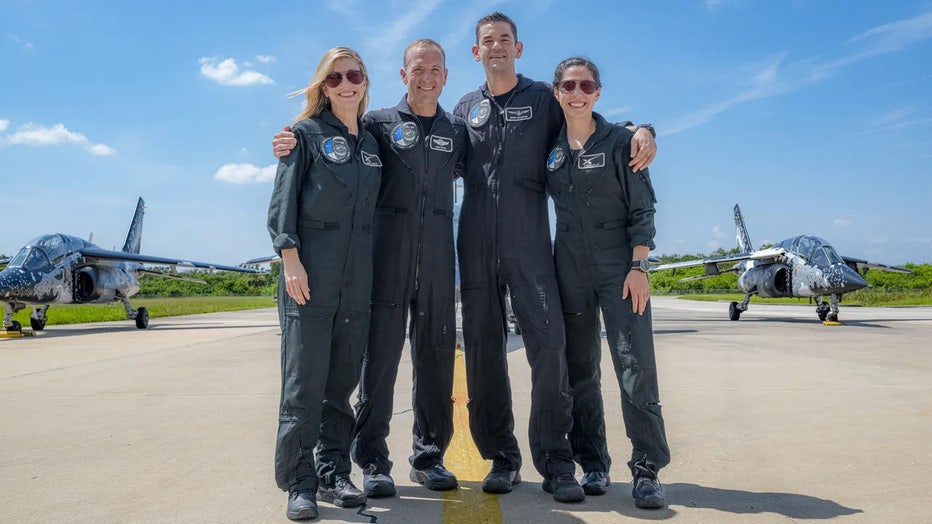Polaris Dawn crew arrives in Florida ahead of first SpaceX spacewalk mission

Polaris Dawn crew from left to right: Jared Isaacman, Sarah Gillis, Anna Menon and Scott Poteet after arriving in Florida on Aug. 19, 2024. (Polaris Program / John Kraus)
CAPE CANAVERAL, Fla. - SpaceX is preparing to launch two of its employees and two other private citizens on the company's most ambitious mission yet, including the first private spacewalk and sending humans into the deepest orbit since the Apollo program.
The Polaris Dawn mission is scheduled to launch on Aug. 26 from NASA's Kennedy Space Center launch pad 39A. The launch window opens at 3:30 a.m. ET on Aug. 26 and runs through 7 a.m. ET, but Mission Commander Jared Isaacman said SpaceX teams are working to narrow down the liftoff time.
The four-person crew arrived in Florida on Monday, landing in four jets on the old space shuttle runway.
Polaris Dawn is part of a series of private spaceflights funded by Isaacman, an American businessman and founder of Shift4Payment. This will be Isaacman's second spaceflight. In 2021, he funded and flew on a SpaceX spaceflight known as Inspiration4 with three other private astronauts. In the coming years, the Polaris Program will culminate with a human spaceflight on SpaceX's Starship, which is still under development in Texas.

Polaris Dawn EVA spacesuit acceptance testing at Johnson Space Center in Houston. (Polaris Program / John Kraus)
FIRST PRIVATE SPACEWALKERS REVEAL JAM-PACKED SCIENCE GOALS DURING POLARIS DAWN MISSION
"The idea is to, you know, develop, test, new technology and operations in furtherance of SpaceX's bold vision to enable humankind to journey among the stars," Isaacman said.
The three other crew members include mission pilot Scott Poteet and SpaceX employees Sarah Gillis and Anna Menon, both mission specialists.
The ambitious private mission has many goals, including a series of spaceflight firsts for private citizens and SpaceX.
After launch, the SpaceX Dragons should reach an altitude of nearly 870 miles above Earth (1,400 kilometers). The deeper orbit is a significant mission milestone for several reasons, as it is more than three times farther than the International Space Station.
"This is the farthest humans have traveled since the last time humans walked on the Moon more than 50 years ago. And, to my crew members, Sarah and Anna will be the women who've traveled farthest from the Earth ever, which I think is pretty is pretty cool," Isaacman said.
The second major objective of the mission is completing the first commercial spacewalk at 430 miles above Earth using the newly developed SpaceX spacesuits. On the third day in space, two space flyers will remain in the spacecraft, but all four will be exposed to the vacuum of space, requiring spacesuits for everyone.
Gillis explained that the Dragon spacecraft had to undergo significant modifications to enable the crew to exit the airlock in space. A new structure called Skywalker, added to the forward hatch, will help the crew navigate out into space with hand and footholds.

Polaris Dawn crew from left to right: Anna Menon, Scott Poteet, Jared Isaacman and Sarah Gillis after arriving in Florida on Aug. 19, 2024. (Photo credit: John Kraus/Polaris Program)
SpaceX plans to livestream the spacewalk using a new communication system with the company's Starlink internet.
A Starlink router connects to a laser system in the spacecraft's trunk, but it requires some finesse to work.
"You might think getting internet might be as easy as just flipping that switch, turning on your internet, but it's not. We're talking about a laser sending information to a Starlink satellite that is moving at orbital velocity (17,500 mph) down to Earth, and then back again, so it's been an incredible development effort by the SpaceX team," Gillis said.
If the Starlink communication system works, it could open up a new option for future missions.
"It has the opportunity to open up an entirely new communication pathway, not just for Dragon, but for armadas of Starships or other satellites or telescopes out there," Isaacman said.
The mission will culminate after about six days in orbit with a Dragon splashdown in one of seven locations around Florida.

